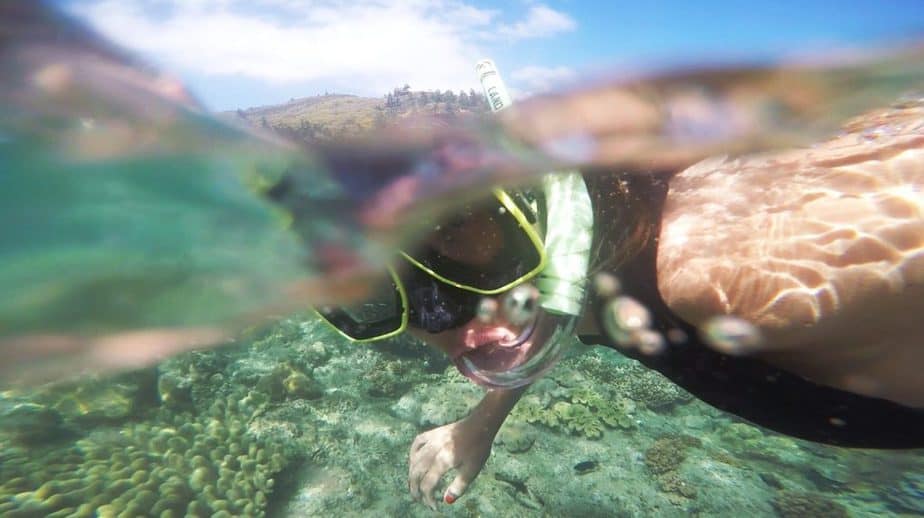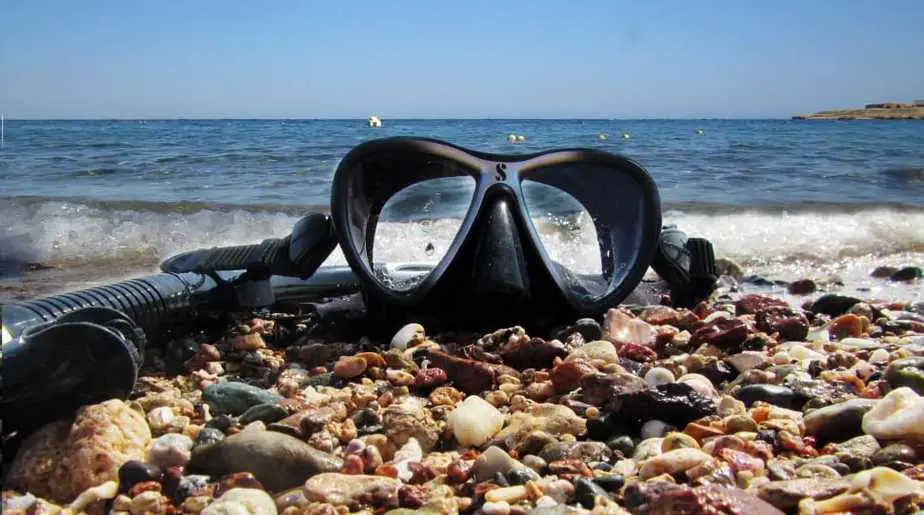If you’ve never snorkeled before, here are some quick tips on how to use a mask, snorkel, and fins. Snorkeling isn’t difficult. As long as you stay calm and do everything cautiously, then you will be safe. Know what you are capable of and stay within those limits if you are not a good swimmer or aren’t wearing a snorkel flotation device. Stay close to the boat or shore and never snorkel alone.
Choosing the Right Snorkel Gear
First you need to pick the right snorkel and a comfortable mask. With the right gear you can spend more time enjoying the sights that the underwater world has to offer, and less time fiddling with poor-fitting, uncomfortable equipment.
A mask and snorkel are the most important pieces of gear, fins are optional but highly recommended. You can still snorkel without fins, but it might be a bit harder.
If you aren’t a strong swimmer, then we recommend you wear a personal flotation device like a snorkel vest. If you’ve never snorkeled before, start off in a swimming pool to test how your mask and snorkel fits and if there are any leaks.
Next, move on to snorkeling in shallow water where your feet can reach the floor, somewhere that has a sandy bottom. Stay away from snorkeling destinations with surge or currents, and the best way to do this is to snorkel in the mornings.
How to Use Your Snorkeling Mask
You should preferably use your own mask and snorkel, but if you are using rented gear then the first thing to do is check if the mask fits properly. Put the mask on your face and hold it lightly in place with your fingers.
Do not use the strap to secure it just yet, now breathe in with your nose. Remove your fingers from the mask. The suction you are creating as you breathe in should keep the mask on your face. If air is leaking out from the skirt and the mask doesn’t stay in place, then the mask is ill-fitting.
If your mask passed the suction test, next adjust the strap so that the mask fits snugly without feeling constrictive. It should sit around the widest section of your head. If the strap is too loose, it can slip down to the neck and cause the mask to leak. If this occurs, then tighten the strap so that it doesn’t slip anymore.
Defogging the Mask And Preventing Leaks
Sometimes when you’re in the middle of snorkeling, your mask can start to fog up and make it difficult to see. If you’re already out in the water, there’s not much you can do except to spit on the lens and rinse with saltwater. Yes, this actually works. However, you could also use a defogging product that can treat the mask lens so that it doesn’t fog up.
If you have a glass lens, some snorkelers recommend scrubbing the mask with toothpaste using a toothbrush to get rid of the oily film that coats the lens. Another option to remove this coating is to treat it with heat.
Keep in mind that after you’ve applied the defogging solution or spat and rinsed your mask, you have to quickly put it on and leave it on. Otherwise, if you take the mask off it will immediately fog again and you will have to repeat the defogging procedure.
Make sure there aren’t any loose strands of hair or facial hair under the mask skirt since this can prevent a tight seal from forming and cause leakage. You can form a tighter seal around the mask by applying silicone grease or a mask sealant around leaky areas.
If you’ve removed the mask while you’re in the water, make sure it’s hanging around your neck. Don’t loosely wear it on your forehead because a strong wave or sudden head movement can cause it to fly off, and then you won’t have a mask anymore.

How to Use Your Snorkel
First, put your mouth over the snorkel mouthpiece and try taking a deep breath through the tube. Exaggerate your breathing, making each breath twice as long and slow as normal. This is important when snorkeling and scuba diving because the snorkel increases the dead air between the air around you and your lungs.
Each breath you exhale releases carbon dioxide which can linger in the snorkel. So it is crucial that your breaths are long and deliberate to get as much fresh oxygen in your lungs as possible, not just old CO2 that you just exhaled. Think of the snorkel mouthpiece like a sports gum shield. Resist the urge to bite down on grip it hard with your teeth; let the mouthpiece sit loosely in your mouth. Otherwise, you can cause jaw aches.
After you’ve gotten used to breathing with a snorkel on land, it’s time to take it for a spin in the water. You can test the snorkel in a bathtub or swimming pool first to help your brain get accustomed to breathing underwater. Once you’re in the water, try to float horizontally along the surface and point your head at a 45 degree angle.
Do not look straight down, as your snorkel will be at a slanted angle if you look straight down. This increases the chances of water flooding in if you don’t have a dry snorkel. Once you’ve found a comfortable position to float in, do not move much. If you stay still you will be blown away at just how much marine life there is.
How to Drain Water from Your Mask and Snorkel
After you’ve snorkeled for a bit your gear should still be relatively dry, however there is a chance that some water has started entering the mask. Don’t worry, this is normal and to be expected. In anticipation of this, you have to know how to “clear” (expel water from) your mask. Clearing the mask also has the added benefit of temporarily defogging your mask.
To do this, look up and push the top of the mask frame on your forehead. This loosens the seal on the bottom (by your nose) and pools the water there. Simply exhale through your nose and the water will drain out from this opening. Quickly seal the mask against your face before any water rushes in. If your mask has a purge valve, you don’t even have to create an opening, just forcefully breathe out through your nose to purge the water.
To clear water from your snorkel, just forcefully breathe out with your mouth to expel water from the purge valve or to send the water out from the top of the tube. The next breath you take should be done cautiously, as there may be some residual drops of water leftover. It is important that you master clearing techniques by intentionally flooding your mask and snorkel. If this sounds complicated, take a look at the video below to get an idea. Practice makes perfect.
How to Use Snorkel Fins
If you are wearing fins, you have to decide when to put them on. If you’re snorkeling from shore, most people put them on at the shore and waddle towards the water. A common mistake is to walk forward with fins. The long blades of the fins are tripping hazards and make it difficult to walk forward, so it is recommended that you walk backwards into the water.
Some snorkelers prefer to walk into the water with fins in hand, and then put on the fins once half their body is submerged. This helps them avoid the awkward fin waddle, however some find wearing fins in the water to be troublesome as well. The choice is up to you.
As for actually putting the fins into action, when floating horizontally you should keep the fins just below the surface. For maximum efficiency, kick gently in a fluid motion from your hips. Even though fins help you swim faster, you’re not in a race and kicking forcefully will disturb the fish and coral.
If you want to save some money or hate dealing with snorkel fins in general, you might be interested in reading our article about snorkeling without fins.
What to Avoid When Wearing Snorkel Fins
In shallow water, be careful not to disturb or damage the sensitive coral and sea fans with your kicks. Do not kick up sand, which will reduce your underwater visibility, scare off the fish, and block the coral from getting sunlight.
Do not touch coral, since they are fragile but strong and sharp enough to cut you. Obviously don’t stand on coral. Many snorkelers that wear long fins accidentally break off branches from coral because they lost track of their position in the water.
Cuts from coral in tropical water can lead to infections quickly. Some coral can sting you or cause itching reactions. In the same vein, you can look but don’t touch marine life because they can sting or bite. Jellyfish stings can cause paralysis which can lead to drowning. Even with protective snorkeling gear, kicking a coral with fins on can damage the fin and pierce through the material.
Next, most marine life is harmless if you leave them alone. They will keep their distance and not bother you. But if you try to touch one, you are putting yourself at risk. Things like stonefish, scorpionfish, and lionfish are highly venomous. Moray eels, sting rays, and sea snakes may also pose a danger. Even harmless looking shells that look idyllic resting on the sea bed may have lethal barbs, such as cone shell barbs. Resist the urge to touch anything!
Staying Safe While Snorkeling
If you find yourself in danger while in the water and cannot swim back or even stand, let others know your distress by waving both arms over your head. Like the SOS, this is a universal distress signal.
When snorkeling, make sure to look up every few minutes to check your surroundings. If you’ve been underwater too long, you may not realize that you’ve drifted farther away from the shore. Furthermore, it’s hard for boats and other people in the water to see you when you’re underwater.
Just having a tiny snorkel tube sticking up is not enough for others to see you. Watch where you’re going to avoid collisions; wear bright snorkeling gear to increase your visibility. If you decide to freedive, surface carefully to avoid getting hit.
Your snorkel mask and snorkel can help you look underwater for a long time, however this exposes your back to the sun. Be aware that the sun’s rays get amplified by the water and will seriously burn your skin without proper UV protection. You should wear a rash guard or snorkel vest to keep your skin protected when snorkeling.


